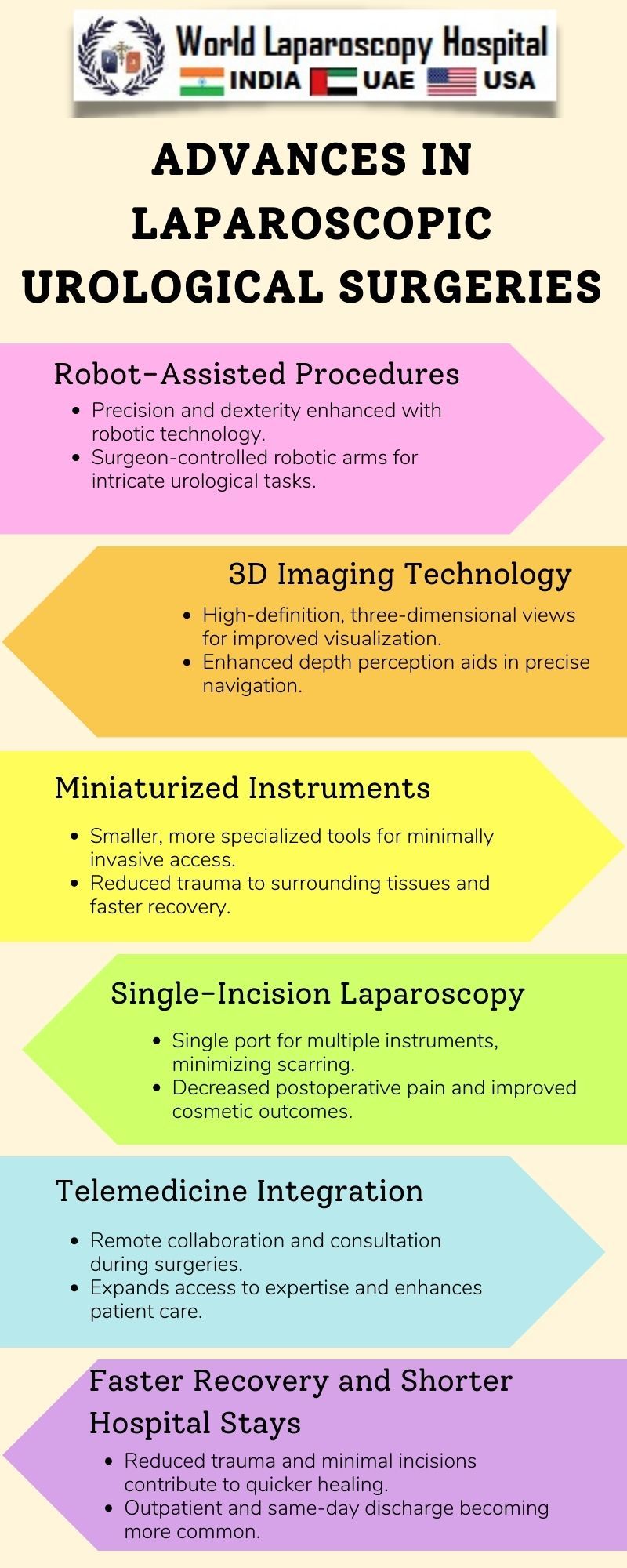Advances in Laparoscopic Urological Surgeries
Advances in Laparoscopic Urological Surgeries
Introduction:
In the realm of urology, the continuous evolution of surgical techniques has paved the way for transformative advancements in patient care. Laparoscopic urological surgeries, once considered pioneering, have now become a cornerstone in the management of various urological conditions. This article delves into the extensive progress witnessed in laparoscopic urological procedures, exploring enhanced technologies, refined surgical approaches, and their collective impact on patient outcomes.

Historical Perspective of Laparoscopic Urological Surgeries:
To appreciate the current state of laparoscopic urological surgeries, it is imperative to trace their historical development. The first laparoscopic nephrectomy, performed by Clayman et al. in 1991, marked a watershed moment. Since then, the scope of laparoscopic interventions has expanded to encompass a wide array of urological procedures, including prostatectomy, cystectomy, and adrenalectomy.
Technological Innovations:
Robotic-Assisted Laparoscopy:
One of the most significant breakthroughs in laparoscopic urology is the integration of robotic-assisted systems. The da Vinci Surgical System, introduced in the early 2000s, enables surgeons to perform intricate procedures with enhanced dexterity and precision. This technology has particularly revolutionized prostatectomies, offering a minimally invasive alternative with reduced blood loss and faster recovery.
Advanced Imaging Modalities:
Laparoscopic surgeries heavily rely on visual feedback, and recent strides in imaging technologies have greatly improved intraoperative visualization. High-definition cameras, three-dimensional imaging, and fluorescence-guided techniques provide surgeons with a clearer view of the operative field, facilitating more accurate and meticulous procedures.
Energy Devices and Hemostatic Agents:
The development of advanced energy devices, such as ultrasonic shears and advanced bipolar instruments, has augmented the efficiency of laparoscopic surgeries. Additionally, hemostatic agents and sealants contribute to reduced bleeding during procedures, further enhancing the safety and effectiveness of urological interventions.
Clinical Applications and Surgical Procedures:
Prostatectomy:
Laparoscopic radical prostatectomy has become a gold standard for the treatment of localized prostate cancer. The precision afforded by laparoscopy, coupled with the benefits of reduced postoperative pain and quicker recovery, has positioned this technique as a preferred option for many patients.
Nephrectomy:
Laparoscopic nephrectomy, initially introduced for living donor kidney transplantation, has evolved to encompass various conditions, including renal tumors and hydronephrosis. The minimally invasive nature of this procedure results in shorter hospital stays and faster return to normal activities for patients.
Cystectomy and Urinary Diversion:
The treatment of bladder cancer often necessitates radical cystectomy. Laparoscopic approaches to cystectomy, combined with innovative techniques for urinary diversion, offer patients the benefits of reduced morbidity and improved quality of life postoperatively.
Adrenalectomy:
Laparoscopic adrenalectomy has gained prominence in the management of adrenal tumors, providing a less invasive option compared to traditional open surgery. The precision of laparoscopy reduces the risk of damage to surrounding structures and accelerates recovery.
Patient Outcomes and Quality of Life:
The transition from open to laparoscopic urological surgeries has significantly impacted patient outcomes and postoperative quality of life. Reduced blood loss, smaller incisions, and shorter hospital stays contribute to quicker recovery times. Patients often experience less pain and discomfort, promoting a more favorable postoperative experience.
Challenges and Future Directions:
Learning Curve:
Despite the numerous advantages, the adoption of laparoscopic techniques poses a learning curve for surgeons. Training programs and simulation technologies play a crucial role in bridging this gap and ensuring the safe implementation of laparoscopic procedures.
Cost Considerations:
While the benefits of laparoscopic urological surgeries are substantial, the initial costs associated with acquiring robotic-assisted systems and advanced instrumentation can be a limiting factor. Efforts to make these technologies more cost-effective and accessible are essential for widespread adoption.
Further Technological Innovations:
The future of laparoscopic urological surgeries holds promise with ongoing research in artificial intelligence, virtual reality, and augmented reality. These technologies aim to further enhance surgical precision, streamline workflow, and provide additional layers of safety.
Conclusion:
Laparoscopic urological surgeries have undergone a remarkable transformation, emerging as a cornerstone in the treatment of various urological conditions. Technological advancements, coupled with refined surgical techniques, have elevated the standard of care, offering patients safer and more effective alternatives to traditional open surgeries. As we stand on the cusp of continuous innovation, the future holds even more exciting possibilities for the field of laparoscopic urology, promising improved outcomes and enhanced patient experiences.
Top
Introduction:
In the realm of urology, the continuous evolution of surgical techniques has paved the way for transformative advancements in patient care. Laparoscopic urological surgeries, once considered pioneering, have now become a cornerstone in the management of various urological conditions. This article delves into the extensive progress witnessed in laparoscopic urological procedures, exploring enhanced technologies, refined surgical approaches, and their collective impact on patient outcomes.

Historical Perspective of Laparoscopic Urological Surgeries:
To appreciate the current state of laparoscopic urological surgeries, it is imperative to trace their historical development. The first laparoscopic nephrectomy, performed by Clayman et al. in 1991, marked a watershed moment. Since then, the scope of laparoscopic interventions has expanded to encompass a wide array of urological procedures, including prostatectomy, cystectomy, and adrenalectomy.
Technological Innovations:
Robotic-Assisted Laparoscopy:
One of the most significant breakthroughs in laparoscopic urology is the integration of robotic-assisted systems. The da Vinci Surgical System, introduced in the early 2000s, enables surgeons to perform intricate procedures with enhanced dexterity and precision. This technology has particularly revolutionized prostatectomies, offering a minimally invasive alternative with reduced blood loss and faster recovery.
Advanced Imaging Modalities:
Laparoscopic surgeries heavily rely on visual feedback, and recent strides in imaging technologies have greatly improved intraoperative visualization. High-definition cameras, three-dimensional imaging, and fluorescence-guided techniques provide surgeons with a clearer view of the operative field, facilitating more accurate and meticulous procedures.
Energy Devices and Hemostatic Agents:
The development of advanced energy devices, such as ultrasonic shears and advanced bipolar instruments, has augmented the efficiency of laparoscopic surgeries. Additionally, hemostatic agents and sealants contribute to reduced bleeding during procedures, further enhancing the safety and effectiveness of urological interventions.
Clinical Applications and Surgical Procedures:
Prostatectomy:
Laparoscopic radical prostatectomy has become a gold standard for the treatment of localized prostate cancer. The precision afforded by laparoscopy, coupled with the benefits of reduced postoperative pain and quicker recovery, has positioned this technique as a preferred option for many patients.
Nephrectomy:
Laparoscopic nephrectomy, initially introduced for living donor kidney transplantation, has evolved to encompass various conditions, including renal tumors and hydronephrosis. The minimally invasive nature of this procedure results in shorter hospital stays and faster return to normal activities for patients.
Cystectomy and Urinary Diversion:
The treatment of bladder cancer often necessitates radical cystectomy. Laparoscopic approaches to cystectomy, combined with innovative techniques for urinary diversion, offer patients the benefits of reduced morbidity and improved quality of life postoperatively.
Adrenalectomy:
Laparoscopic adrenalectomy has gained prominence in the management of adrenal tumors, providing a less invasive option compared to traditional open surgery. The precision of laparoscopy reduces the risk of damage to surrounding structures and accelerates recovery.
Patient Outcomes and Quality of Life:
The transition from open to laparoscopic urological surgeries has significantly impacted patient outcomes and postoperative quality of life. Reduced blood loss, smaller incisions, and shorter hospital stays contribute to quicker recovery times. Patients often experience less pain and discomfort, promoting a more favorable postoperative experience.
Challenges and Future Directions:
Learning Curve:
Despite the numerous advantages, the adoption of laparoscopic techniques poses a learning curve for surgeons. Training programs and simulation technologies play a crucial role in bridging this gap and ensuring the safe implementation of laparoscopic procedures.
Cost Considerations:
While the benefits of laparoscopic urological surgeries are substantial, the initial costs associated with acquiring robotic-assisted systems and advanced instrumentation can be a limiting factor. Efforts to make these technologies more cost-effective and accessible are essential for widespread adoption.
Further Technological Innovations:
The future of laparoscopic urological surgeries holds promise with ongoing research in artificial intelligence, virtual reality, and augmented reality. These technologies aim to further enhance surgical precision, streamline workflow, and provide additional layers of safety.
Conclusion:
Laparoscopic urological surgeries have undergone a remarkable transformation, emerging as a cornerstone in the treatment of various urological conditions. Technological advancements, coupled with refined surgical techniques, have elevated the standard of care, offering patients safer and more effective alternatives to traditional open surgeries. As we stand on the cusp of continuous innovation, the future holds even more exciting possibilities for the field of laparoscopic urology, promising improved outcomes and enhanced patient experiences.
